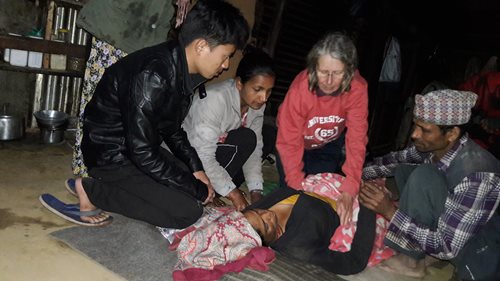Midnight. The light goes on in the room I’m sharing with two auxiliary nurse midwives. A babble of fast Nepali. Something about pain. It doesn’t seem to be a fall or an accident. In my sleep fog, I can’t make out the problem but it certainly sounds urgent. I start to dress. I’m aware of a sound like a river in spate. There is no river nearby. The rain is torrential. I locate my head-torch and follow Dharmajan out into the tempest. The unpaved roads of Bhotang have become rivers. I charge up the steep incline, acutely aware this is not the time to slip into a ditch, acutely aware I’m already out of breath. The air is a bit thinner up here. The road levels out a little, then Dharmajan plunges down a set of uneven stone steps and along a narrow alley. I slip off my sodden trainers and step inside a makeshift home with a mud floor typical of the shelters people have made since the earthquake three years ago. I register woodsmoke.
The patient is splayed out on the floor near the kitchen area and open fire. She is not moving. I wonder if she is dead. Her relatives are calm though – and so is Bhisma, the Health Assistant who had called for me. I had expected the patient to be old and frail. She is neither but she is warm and her pulse and breathing steady. When my touch rouses her though she becomes distressed.
Bhisma had made an initial assessment and given the patient an injection for the pain but clearly she is still in agony. She’s pointing to her left side, low down in her back. I try to gather more information though everyone is speaking at once and my grasp of Nepali could be better. She is 36 but looks 56. The pain came on suddenly at 5pm. My first thought is a kidney stone – which has the reputation as causing one of the worst pains of any clinical condition, but more likely this is a ‘slipped disc’. But why is she sliding in and out of consciousness? The rest of my assessment only confuses me – things don’t add up. She is in such pain I wonder whether she has something life-threatening going on. I would like to evacuate her to a hospital but even that is impossible in the middle of the night and even in daylight hours it isn’t going to be easy. She’s not in shock though. She is clinically stable and we can do little more than ease her pain and see how she is in the morning. We leave saying she needs to drink plenty of water as she is getting dehydrated.
In the morning she looks little better. The pain had shifted. She remains stable if more dehydrated. We discuss evacuation again but know this will be tough for her, yet she is deteriorating and we’ve already missed the only bus that leaves Bhotang each morning. The alternative would be in the back of a timber lorry.
By six that evening she still hasn’t passed any urine. She’s been dry for over 24 hours so Bhisma puts up an intravenous infusion, dangling it from a bit of timber that holds up the corrugated iron roof. This perks her up considerably and we plan for her to leave on the morning bus next day. She eats a little rice but tells us of new symptoms including breathlessness. I feel guilty for not having the confidence to keep her at home as I know the evacuation will hurt, and cost the family dear.
Next day, with another pain-killing injection and her family’s help she manages to board the bus and reaches the small hospital in Melamchi who decide she needs evacuation to a larger hospital Kathmandu. My colleagues eventually conclude she has ‘simple’ back pain with no life- or health-threatening complications. A week later she is back at home and her pain has gone.
The whole experience was sobering for me. Clinical practise is so much more scary when a misdiagnosis could lead to serious consequences and even death. And making an accurate diagnosis without recourse to any tests, scans or x-rays is just that little bit more challenging. I am in awe of my local clinical colleagues who work under this pressure, providing 24/7 cover for months on end without a break.
 |
| PHASE staff, Bhimsa and Saraswati, with our distressed patient |
I spent a couple of weeks this month mentoring health professionals employed by PHASE Nepal in Sindhupalchowk district of Nepal. These impressive people in turn work and support government clinicians in the most remote regions of Nepal. PHASE also support communities by promoting diversification of agriculture and home gardens thereby improving the nutrition of villagers who lack access to markets. They are happy to receive donations for this worthy work via
http://www.phaseworldwide.org
You'll find more on my volunteering work for PHASE by clicking
Village clinics and
Call-out